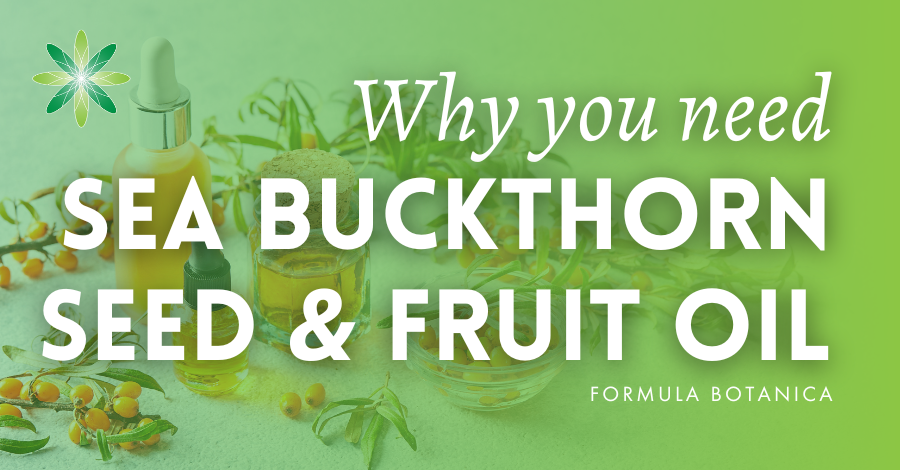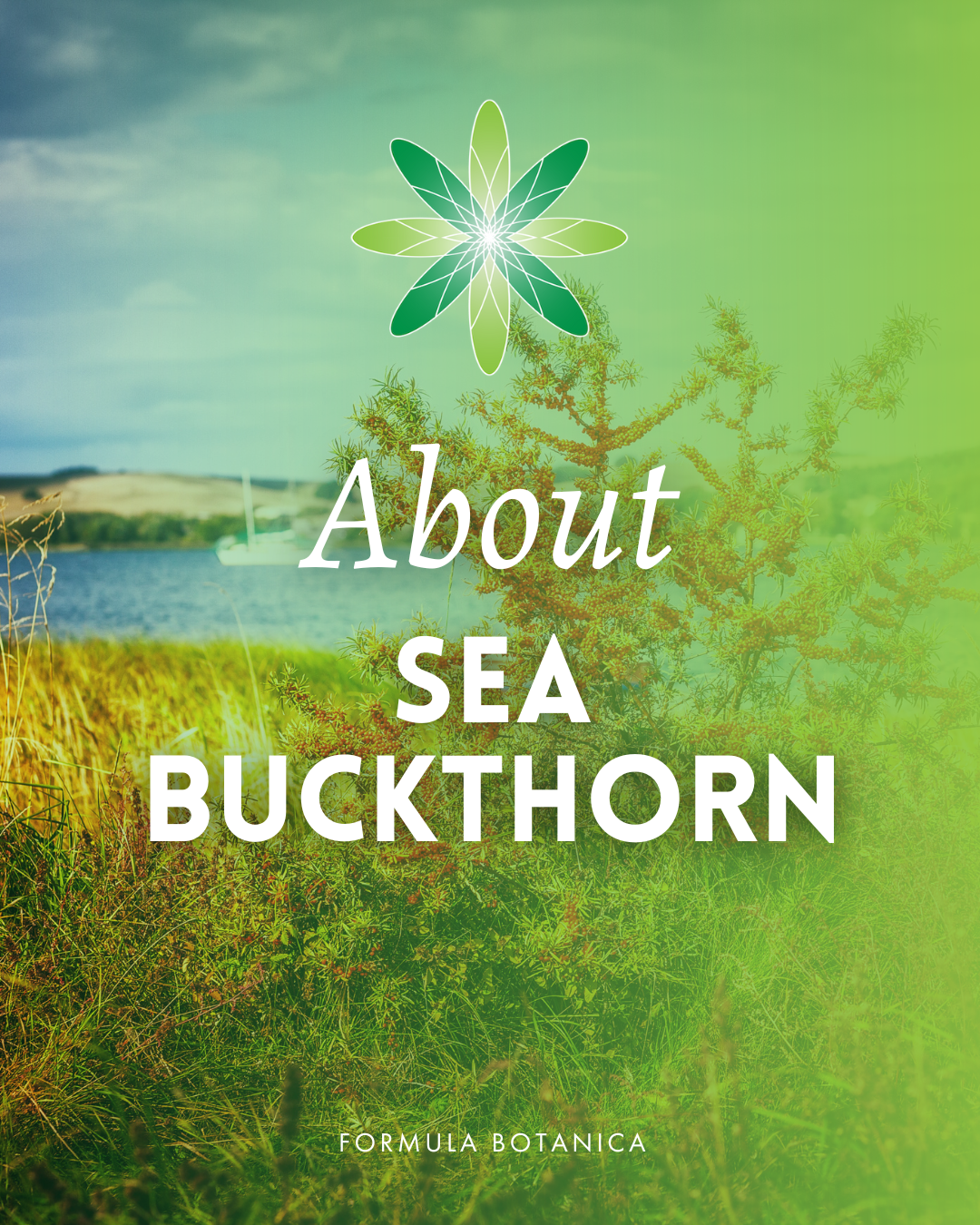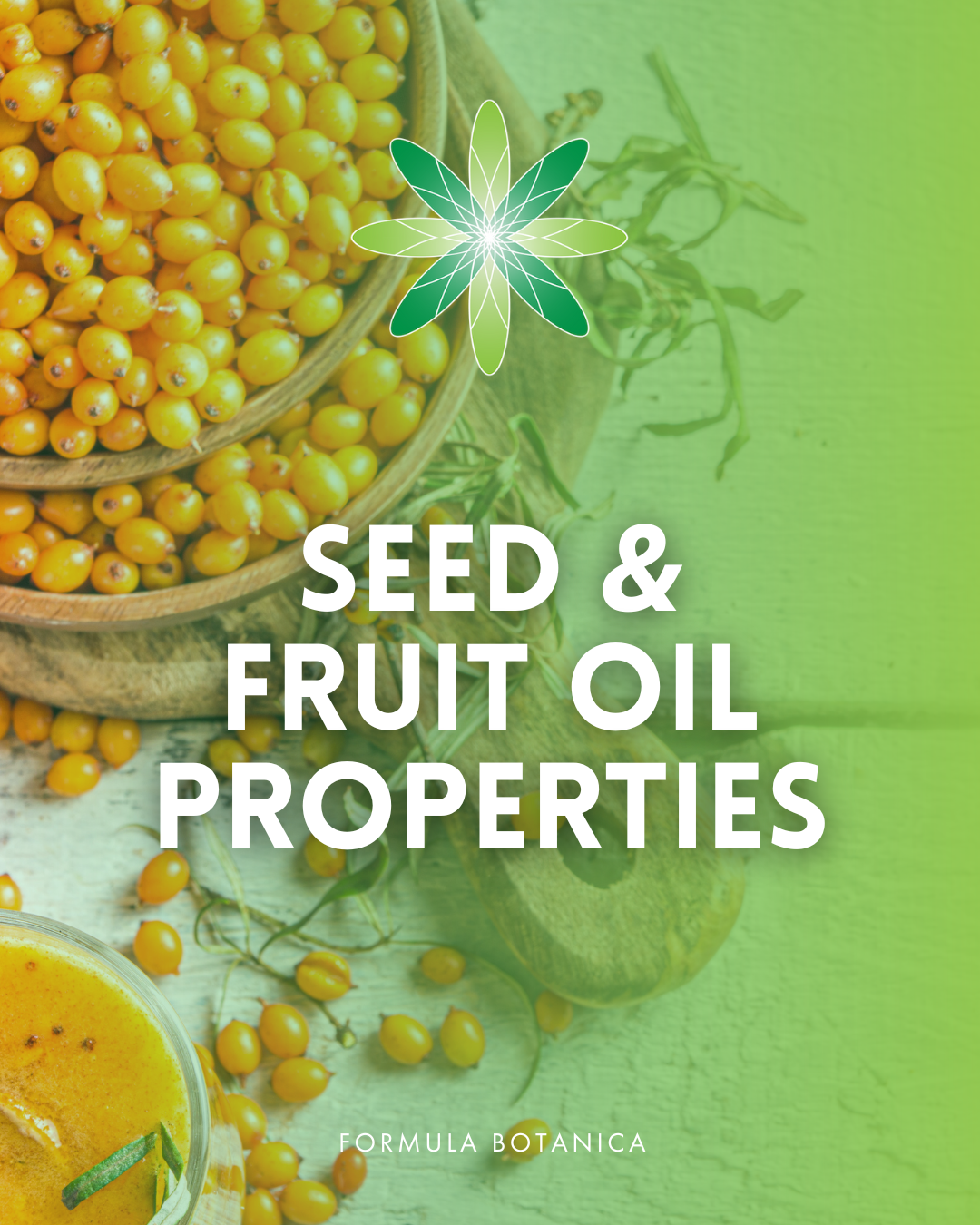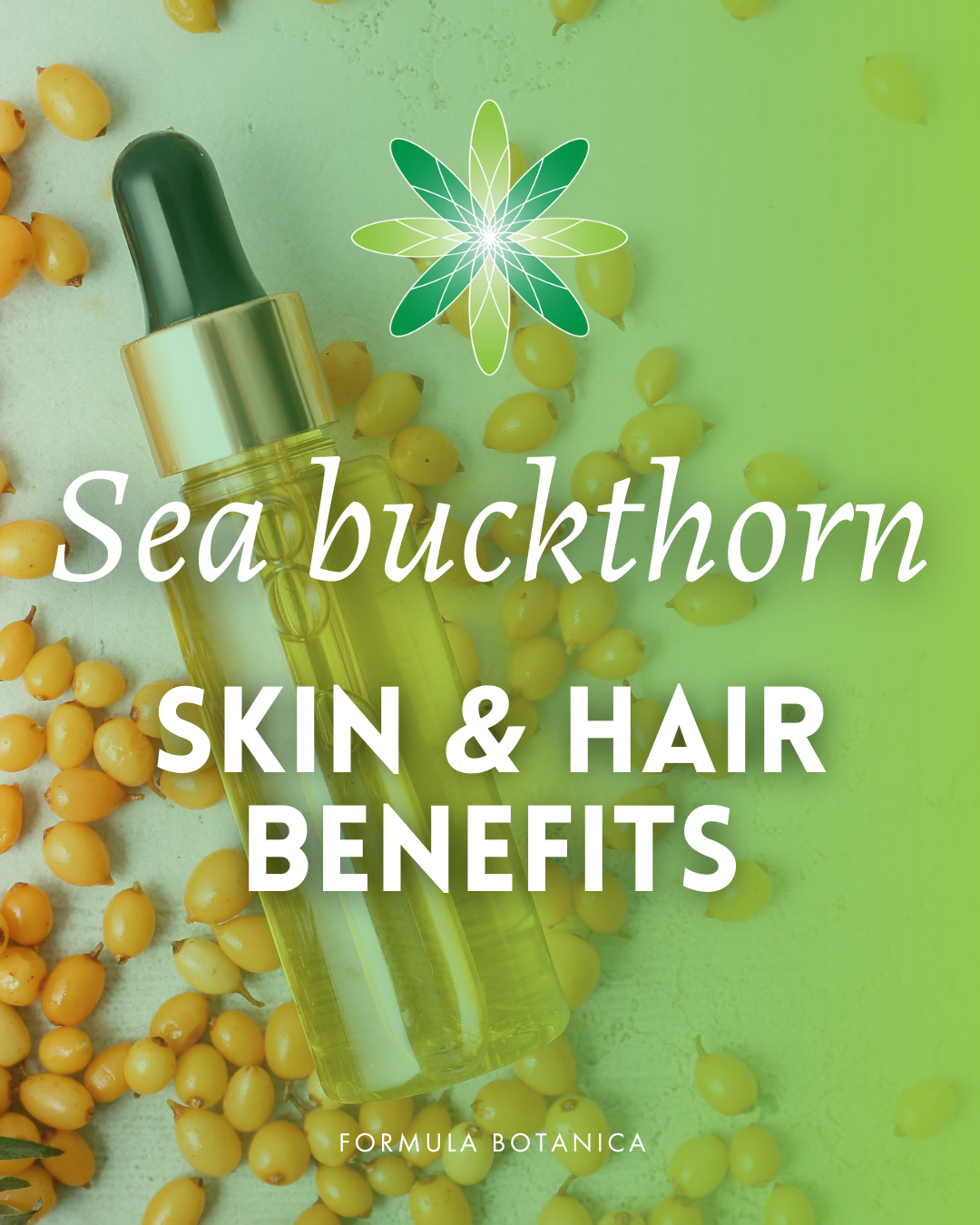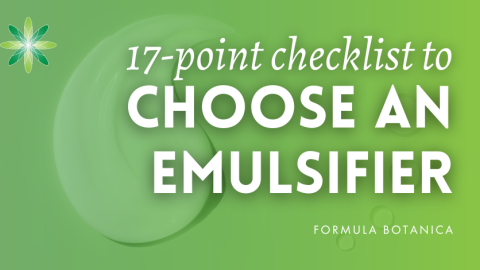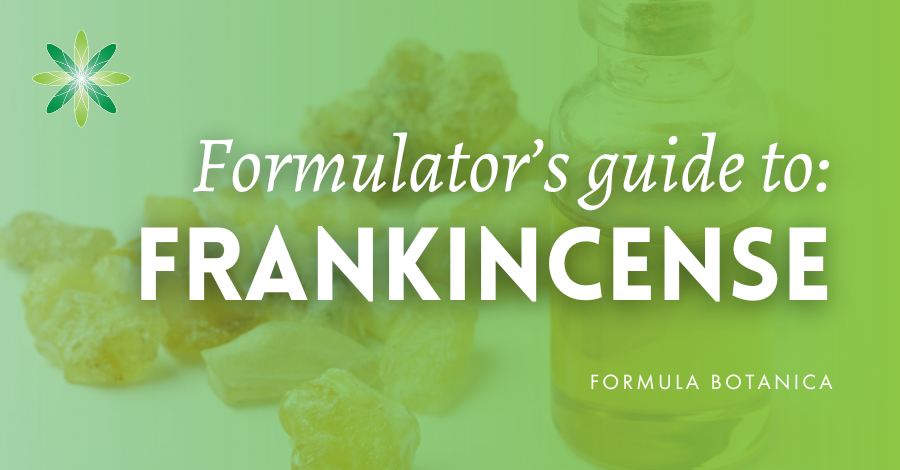High up in the Himalayas, bravely enduring temperatures as low as -40°C, stands a thorny shrub with densely-packed bright orange berries. Outlasting the worst of frost and drought, and thriving also in the salty soil and sea spray of the northern Baltic coast, sea buckthorn is one of the most robust plants on the planet.
Similar to ectoine – the high-performance ingredient that gets its special, skin-beneficial properties by surviving harsh environments – this berry contains concentrated beauty benefits.
With soaring levels of carotenoids and rare palmitoleic acid, sea buckthorn oil is a powerful cosmetic ingredient and a superstar for skin and hair. In this article, you get to find out just how and why it’s your best-kept secret as cosmetic formulator.
What is sea buckthorn oil?
Sea buckthorn oil is extracted from both the fruit and seeds of the sea buckthorn shrub. Also known as seaberry or Siberian pineapple, this Nordic berry grows naturally in the sub-alpine areas of mountain ranges and in various cold-temperate regions of Europe, Russia and Asia. It’s also cultivated in Canada. For some other Nordic oils to explore, as well as best-in-class carrier oil options for nourishing skincare and haircare, give these read:
Top 10 Nordic beauty ingredients and their benefits
10 Best carrier oils for skin and hair
Sea buckthorn (Hippophaes rhamnoides) belongs to the oleaster (Elaeagnaceae) family. Its botanical name is from the Greek ‘hippos’ (horse) and ‘phaos’ (to shine) because the ancient Greeks fed these berries to horses to keep their coats shiny.
Four types of oils are available for cosmetic formulation:
- the cold-pressed fruit oil (sometimes called berry or pulp oil)
- the cold-pressed seed oil
- the CO2-extracted carrier oils of both
If you’re not sure what CO2 extracts are, we have you covered in CO2 mystery and methods explained.
Properties of sea buckthorn oil
Sea buckthorn fruit and seed oils both contain an impressive amount of vitamin E, phospholipids (some of which are lecithin), and sterols (beta-sitosterol). But, there are significant differences between them – in their fatty acid profiles, constituents, and physical characteristics. Let’s have a closer look.
Sea buckthorn fruit oil
INCI: Hippophae Rhamnoides (Sea buckthorn) Fruit Oil
The two most prized components of this oil are high levels of palmitoleic acid and carotenoids. It contains 24–42% palmitoleic acid, which is higher than any other plant oil (and there aren’t many that have it to begin with), along with about 3-30% oleic acid and 1.7-6.8% linoleic acid.
Some sources include gamma-linolenic acid (GLA), although it is not clear if it is in the oil itself or converted in the skin from linoleic acid (i). Its deep red-orange hue is due to the abundance of carotenoids. When absorbed by the skin, they are processed to become retinol and retinyl esters, the storage forms of retinoic acid, the active form of vitamin A. (ii).
The oil smells earthy and almost like a butter because that’s almost what it is; its 24-42% palmitic acid content gives this oil substance and it will solidify in cold temperatures. If jojoba oil is a liquid wax, then sea buckthorn oil is a like a liquid butter. The phospholipids lend even more softness and body to this oil.
Sea buckthorn seed oil
INCI: Hippophae Rhamnoides (Sea buckthorn) Seed Oil
In contrast to the fruit oil, sea buckthorn seed oil contains only small amounts of palmitoleic acid (about 4.4%), but it still has plenty of value for cosmetic formulators.
It contains about 28-45% linoleic and 35% alpha-linolenic acids making it lighter on the skin, faster to absorb, and more suitable than the fruit oil for some formulas and skin types – in fact, this oil has a more balanced ratio of oleic, linoleic and linolenic fatty acids. It has about 5-11.3% palmitic acid and is lower in carotenoids, so the colour is typically less intense.
Sea buckthorn CO2 extracts (fruit and seed) INCI are:
INCI: Hippophae Rhamnoides (Sea buckthorn) Fruit Extract
INCI: Hippophae Rhamnoides (Sea buckthorn) Kernel Extract
When you compare fatty acids and constituents, the CO2 extracts aren’t much different from the cold-pressed oils. However, the extracts are more concentrated and can bring in more volatile compounds. For instance, the CO2 fruit extract is cloudy, thicker and darker than the cold-pressed oil, and it smells fresher, tart and pleasantly fruity.
Benefits of sea buckthorn oil for skin and hair
It is the knockout ingredient for mature skin
Few oils pack more of a punch than sea buckthorn fruit oil in formulations for mature skin, such as creams, serums and balms.
Generous amounts of palmitoleic acid helps stimulate skin regeneration, which in turn helps repair UV damage and encourage collagen production for plumper-looking skin. Carotenoids (pro-vitamin A) are antioxidants and reduce the appearance of fine lines (iii).
Furthermore, the large amount of palmitic acid locks in moisture with an occlusive layer and helps prevent trans-epidermal water loss (TEWL). Phospholipids and beta-sitosterol also help fortify the skin barrier while softening skin and improving its elasticity and firmness (i).
For some background on how the skin barrier functions, see our comprehensive guide:
Skin barrier 101: essential guide for natural cosmetic formulators
Sea buckthorn: the win-win for oily skin
If you’re formulating a cream or serum for oily or blemish-prone skin, the plentiful polyunsaturated fatty acids in sea buckthorn seed oil are what these skin types crave. It’s been shown that oily, acne-prone skin has lower levels of linoleic acid (i).
Linoleic acid may be lightweight, but it’s mighty – it helps regulate sebum and strengthen the skin barrier. The seed oil retains a low level of carotenoids for a micro dose of pro-vitamin A, and it’s still packed with antioxidants, phospholipids and sterols for softness and elasticity. A bit of palmitic acid is also there to smooth and protect without feeling too heavy on the skin.
For an in-depth read on the benefits of including botanical oils in your formulations, see:
Sea buckthorn oil in haircare
That earlier nod to shiny horses probably tipped you off about the benefits of sea buckthorn fruit and seed oil in haircare. It is superb as an addition to shampoos, conditioners, masks and oils for the hair and scalp.
Sea buckthorn oils (fruit and seed) are good for all hair types because they bring strength and shine to the hair shaft and restore elasticity. Linoleic acid (and the resulting GLA) can help regulate scalp oil and boost blood circulation to promote hair growth (i,iii).
Tips for formulating with sea buckthorn oils
Stability and shelf life
Sea buckthorn fruit oil mostly comprises monounsaturated fatty acids (MUFAs). These, combined with a high percentage of saturated palmitic acid and antioxidant vitamin E, give the cold-pressed oil great stability against heat and oxidation, plus they help extend its shelf life. As such, sea buckthorn oil can be heated for use in lip balms and body balms, and added to the heated oil phase of emulsions.
Sea buckthorn seed oil, in contrast, is mostly made up of polyunsaturated fatty acids (PUFAs), so it’s more prone to oxidation and heat sensitivity, and it has a shorter shelf life. It’s best used in cold-process formulation or added at the cool-down phase under 40°C in emulsions. As well, this one should be stored in the refrigerator to help extend its longevity.
The CO2 extracts offer a longer shelf life than the cold-pressed oils, but it’s a good idea to store the seed CO2 extract in the fridge due to its high PUFA profile.
Usage rates
The intense red colour of the fruit oil can stain the skin if you add too much (thankfully, it’s effective in small doses). Usage rates can vary so it’s best to follow supplier recommendations (and your own judgement). All sea buckthorn oils are safe to use at 100%, but we can’t think of an instance where it makes sense to do so. Up to 20% is often more than enough when using the fruit oil.
The seed oil is typically lighter in colour so you can use more of it without staining the skin or hair. However, we’ve seen some dark seed oils around, so you’d have to adjust the usage rate if you are worried about the colour staining. Again, best to follow supplier advice, but you can usually go quite high with this one.
Sea buckthorn CO2 extracts (fruit and seed) are more concentrated so usage is lower, around 1% (or under) – though again, this can vary. We’ve seen the seed extract used in formulations up to 50%.
Bonus formulation tip
Use a combination of the fruit oil and the seed oil in your formula to take advantage of the best of both sea buckthorn oil benefits.
5 formulations with sea buckthorn oil benefits
Nighttime facial oil
Sea buckthorn CO2 extract is the star here. While sea buckthorn is included in this formulation aimed at mature skin, its relatively lightweight texture makes it suitable for most skin types.
Oat and cranberry body balm
This is a rich winter balm with another Nordic ingredient – cranberry seed oil. Swap the rosehip CO2 extract in the cool-down phase with sea buckthorn CO2 fruit extract.
After-sun body oil
Palmitoleic acid and sterols in sea buckthorn fruit oil make a wonderful addition to after-sun products. Simply replace the buriti oil with cold-pressed sea buckthorn fruit oil.
Sunshine Amazonian body melts
To stick with the Amazonian theme, replace half the buriti oil with cold-pressed sea buckthorn fruit oil. Or keep 9% buriti oil and use the sea buckthorn CO2 fruit extract to make up the 0.9% remaining.
Revitalise your locks: how to make a rosemary scalp and hair oil
Sea buckthorn oil has many of the same benefits as the horse chestnut oil in this formula. Swap the latter with cold-pressed sea buckthorn fruit oil – or use the seed oil for quicker absorption and a lighter texture.
FREE TRAINING
Learn how to become an
Organic Skincare Formulator
FREE TRAINING
How to become an
Organic Skincare Entrepreneur
FREE TRAINING
How to become an
Organic Skincare Entrepreneur
Further reading and references
(i) Aleksandra Zielińska and Izabela Nowak: Abundance of active ingredients in sea-buckthorn oil, Lipids in Health and Disease, May 19, 2017.
(ii) Christophe Antille, Christian Tran, Olivier Sorg, Jean-Hilaire Saurat: Topical beta-carotene is converted to retinyl esters in human skin ex vivo and mouse skin in vivo, Experimental Dermatology, September 13, 2004.
(iii) Marijana Koskovac, Snezana Cupara, Ana Barjaktarevic, et. al: Sea Buckthorn Oil—A Valuable Source for Cosmeceuticals, Cosmetics, 2017.
Leave us a comment

Shauna is a former freelance writer at Formula Botanica. A former aesthetician, Shauna is also an active formulator and perfumer, and a member of the Formula Botanica community.

